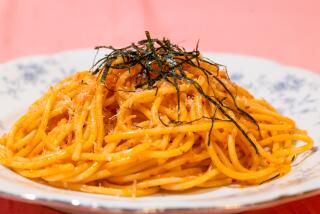Stock Up for Speed
- Share via
Most nights I want my meals to be fast and low in fat. One of my secrets: a well-stocked pantry.
Of course, I keep nonfat chicken stock on hand. Nonfat egg substitute is another staple I’m rarely without; it keeps a relatively long time in the refrigerator. One surprising basic ingredient in my kitchen is Chinese-style dry noodles; they come in a convenient 5-pound box and they work in a variety of dishes, including soup.
Most of the other ingredients for this dinner can be picked up in many supermarkets and in any Chinese grocery store. For a great ending to this dinner, try a cool melon sorbet from the freezer case of your supermarket or splurge and have a Chinese almond cookie with hot jasmine tea.
MENU (Under 30 Minutes)
Seafood Noodle Soup
Pea Shoot Salad
Melon sorbet or Chinese almond cookies
Jasmine tea
INGREDIENTS
STAPLES
Cornstarch
Garlic
Olive oil
Sesame oil
Salt
Jasmine tea
Seasoned rice vinegar
SHOPPING LIST
1 bunch basil
1 (49 1/2-ounce) can nonfat chicken broth
3 baby bok choy
1 bunch cilantro
1 pint melon sorbet or 1/2 dozen Chinese almond cookies
1 (4-ounce) carton nonfat egg substitute
1 pound frozen mixed fish, shrimp and calamari balls
6 shiitake mushrooms
1 (5-pound) pound Chinese-style dry noodles
6 ounces pea shoots
1 (1/2-ounce) bottle Sichuan peppercorns
COUNTDOWN
30 minutes before: Bring chicken broth to boil for soup.
25 minutes before: Add fish and seafood balls to boiling broth. Slice mushrooms and bok choy.
15 minutes before: Add mushrooms and bok choy to broth. Blend together cornstarch and water. Stir into broth. Bring water to boil for noodles.
10 minutes before: Drizzle egg substitute into soup, cover and let stand. Add noodles to boiling water. Prepare and combine ingredients for vinaigrette.
Last minute: Drain noodles and divide into serving bowls. Spoon over soup with broth. Garnish with cilantro leaves. Toss pea shoots with vinaigrette.
Before dessert: Brew tea and serve sorbet or cookies.
SEAFOOD NOODLE SOUP
1 (49 1/2-ounce) can nonfat chicken broth
1 pound frozen fish, shrimp and calamari balls
6 fresh shiitake mushrooms, sliced
3 baby bok choy, cut into 1-inch slices
6 tablespoons cornstarch
1 2/3 cups water
1/4 cup nonfat egg substitute
2 teaspoons sesame oil
1/4 pound Chinese-style dry noodles
Cilantro leaves
Bring chicken broth to boil in saucepan. Add fish, shrimp and calamari balls. Return to boil. Reduce heat to simmer; cover and cook about 10 minutes, until seafood balls are cooked through. Add mushrooms and bok choy and simmer few more minutes.
Blend together cornstarch and water until smooth. Stir into bubbling broth. Return to simmer and cook, stirring occasionally, until broth is clear and thickened, about 2 minutes. Slowly drizzle egg substitute into soup, cover, remove from heat and let stand 1 minute. Stir in sesame oil.
Cook noodles in boiling water in 3-quart saucepan 5 to 6 minutes. Drain and divide among 4 serving bowls. Spoon soup over noodles. Garnish with few cilantro leaves.
4 servings. Each serving:
351 calories; 482 mg sodium; 172 mg cholesterol; 4 grams fat; 39 grams carbohydrates; 36 grams protein; 0.56 gram fiber.
PEA SHOOT SALAD
8 cups pea shoots
1/4 cup chopped basil
1 teaspoon minced garlic
1/4 cup seasoned rice vinegar
2 tablespoons olive oil
2 tablespoons water
Salt
Coarsely ground Sichuan peppercorns
Rinse pea shoots under cold water and drain. Remove any tough stems. Combine basil, garlic, rice vinegar, olive oil, water, salt and Sichuan pepper to taste. Toss with pea shoots.
4 servings. Each serving:
126 calories; 87 mg sodium; 0 cholesterol; 7 grams fat; 13 grams carbohydrates; 7 grams protein; 1.76 grams fiber.
(BEGIN TEXT OF INFOBOX / INFOGRAPHIC)
Kitchen Tip
All oils (with a few exceptions, such as whale and shark oil) have the same total amount of fat: about 14 grams per tablespoon. They vary, of course, in the proportion of saturated fat. In addition, some oils go a lot further in cooking because of their fuller flavors.
Just a touch of sesame oil, for instance, can make a dish taste great (and it has just 2 grams of saturated fat per tablespoon). Store sesame oil in the refrigerator to keep it from turning rancid if you do not use it frequently.
* Sichuan peppercorns are not a kind of peppercorn but the dried flower buds of the Chinese prickly ash tree. Their peculiar taste, at once hot and numbing, has been described as everything from turpentine-like to “a combination of clove and cedar”; both descriptions seem equally accurate. They can be ground in a normal pepper or spice grinder, or they can be coarsely cracked between a heavy pan and a work surface.
* When you get right down to it, our vegetable vocabulary is fairly limited. While we’re big on the roots and fruits of edible plants, there’s a lot we overlook. In much of Asia, for example, the shoots or new growth of various vegetables are consumed as well. In a well-stocked Southeast Asian grocery, you’ll find the shoots of various squash, melons and legumes sold in tightly bound bundles that look as if they might be more at home in a florist’s shop. Among the most delicious are pea shoots and pea leaves, which are often stir-fried with garlic. Remove any woody growth and rinse well before using.
SHORTCUTS
Cooks around the world love a good convenience food. Chinese cooks, for instance, sometimes use frozen fish and seafood balls, made from ground fish. They are a quick way to add protein to noodle soups. Locally, you can find the product in Chinese grocery stores and in some area supermarkets.
More to Read
Eat your way across L.A.
Get our weekly Tasting Notes newsletter for reviews, news and more.
You may occasionally receive promotional content from the Los Angeles Times.










